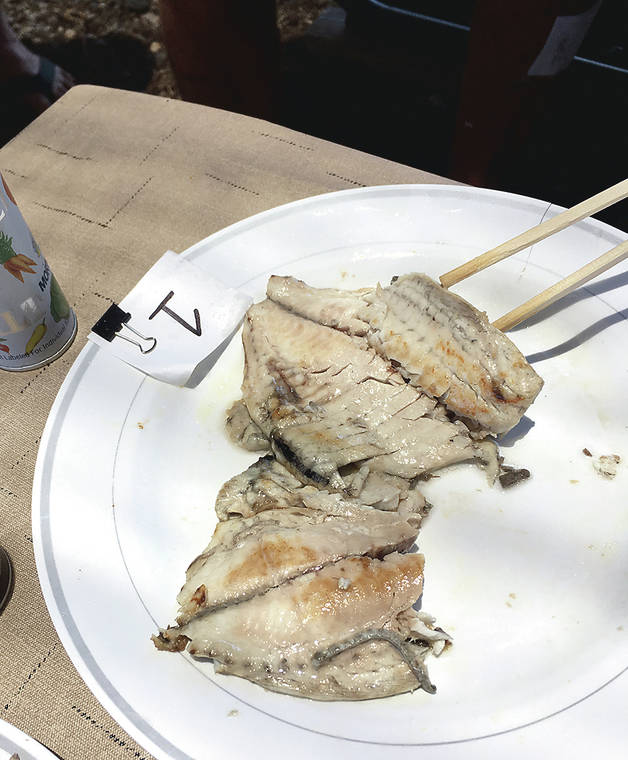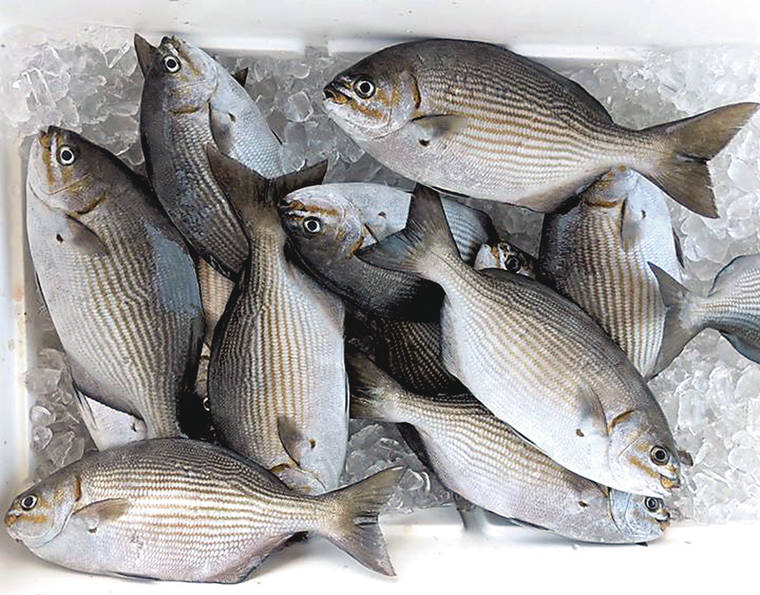My hanai brother, Syd Kraul, grew nenue fish from eggs that he got from the brood stock at Kampachi Worldwide Holdings, also known as Kampachi Farms, in two holding tanks at OTEC in Kailua-Kona. Most fishermen think of this fish as a “rubbish” fish as it eats limu and often tastes like grass or, interestingly, can be described as “fishy.” When gutted, the gut smells pretty bad, as it lives off a diet of limu and sand.
For those reasons, I was very curious how aquacultured nenue would taste.
The first tank was fed special fish food made of 78% duckweed, 15% wheat flower and 5% oil, and the other tank tilapia food. The goal was to develop a successful feed without fishmeal. The experiment proved that duckweed feed will work well as a commercial fish feed.
I first heard about duckweed when I visited Adrian Barnes at the University of Hawaii aquaculture department in Panaewa. He talked about looking at raising it in an adjacent property for tilapia feed. It is a common freshwater weed found worldwide, except in Hawaii and one other state.
It is an easy plant to grow, and some people might think of it as a pest because it reproduces rapidly, doubling in just 16 hours to two days, depending on the growing environment. It is a two-leaf floating plant that grows in still ponds. The benefits of duckweed include: being a cost-effective renewable energy or biofuel, water filtration, mosquito prevention, prevention of algae growth, reduction of evaporation and being feed for fish and animals and food for humans.
Since duckweed thrives on much, it can clean water from farms rearing cows, hogs and chickens. The runoff can leach down into the water tables. Duckweed can clean this water by absorbing the resulting chemicals. Just think, the best nutritional situations for duckweed growth are in water with decaying organic material, provided it has a steady supply of nutrients.
Because duckweed covers the entire surface, it blocks mosquitoes from laying eggs. In areas where malaria, yellow fever, dengue fever and the Zika virus are prevalent, this tiny plant could be used to save many lives.
In many Asian countries, dried and frozen duckweed is used as food for shrimp.
Duckweeds contain 20%-35% protein and therefore can be a substitute for vegetable protein in cereal grain-based diets.
So my own conclusion after tasting raw slices of sashimi and fried fillets in vegetable oil was that the raw flesh was fresh and tasty, with no grassy taste. The cooked fish was clean and tasty. I felt there was no difference in taste in the duckweed or tilapia food but thought the texture of the fish that was fed duckweed had a better texture or chew. The tilapia food fish had a softer, mushier texture when eaten raw.
Nenue are scientifically known as Kyphosus hawaiiensis, and was named by two Japanese ichthyologists, Keiichi Sakai and Tetsuji Makobo, as this particular species is only found in the waters around the islands.
Eating the raw nenue made me think of Chinese raw fish salad, which is very simple to make but delicious for a warm, humid lunch or dinner.
Chinese Raw Fish Salad
1 Japanese cucumber, seeds removed, julienne cut with a mandoline
1 carrot, peeled and julienne cut with a mandoline
1 daikon, peeled and julienne cut with a mandoline
1/4 cup or more pickled Japanese ginger (recipe follows)
1/2 pound raw white fish, nenue if available
Dressing:
Juice of one lime
5 tablespoons plum sauce
2 teaspoon sesame seed oil
Hot water to achieve desired consistency
Toss vegetables, raw fish slices and dressing together with chopsticks. Serve immediately.
• • •
Pickled ginger, also called gari or amazu shoga, is served with sashimi and sushi and is easy to make. You need very young ginger that is white in color to make it.
Gari
1/2 to 1 pound very young white ginger, peeled (when ginger is young, you can rub the skin off)
1 1/2 teaspoon sea or kosher salt
Slice the peeled ginger thinly (you can use the mandoline) and sprinkle with salt. Let stand for 30 minutes. Place in a clean jar.
In a pot, boil:
1 cup rice vinegar
1/3 cup sugar
Pour over ginger in jar. Allow to cool, refrigerate until ready to use.
• • •
Nenue fillets would be great with sweet and sour sauce.
Fish with Sweet and Sour Sauce
Serves: 4-6
2 pounds white fish such as nenue fillets
Batter:
1/2 cup flour
1/2 cup cornstarch
1/2 cup water
1/2 teaspoon salt
1 large egg
1 tablespoon soy sauce
Sauce:
1 tablespoons cornstarch
1/2 cup sugar
1/3 cup vinegar
2 tablespoons vegetable oil
1 teaspoon soy sauce
Combine batter ingredients until smooth. Dip fish in batter and deep fry until golden brown. Combine sauce ingredients and cook until translucent and thickened.
Pour over fried fish and serve.
Correction:
I wrote about Cafe Boba a couple of weeks ago and need to make a correction on the owners. Shane Shitabata, the marketing executive for Cafe Boba, told me his father, Eddie Shitabata, and Shane’s brother-in-law, James Kim, are the owners.
Email Audrey Wilson at audreywilson808@gmail.com.









